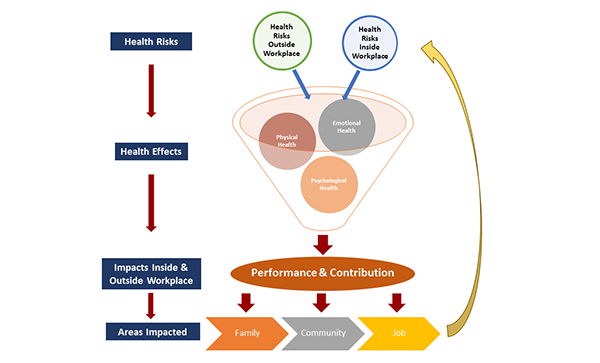

Introduction
As the COVID-19 Pandemic continues, employee health has been a major focus for both policy makers and businesses. The Pandemic has highlighted the risk of infectious diseases and has put an emphasis on business roles in preventing their spread to employees and customers. While these precautions, policies and procedures are crucial during a pandemic, the reality is that during times like these, other health risks, like emotional and psychological stress, may fall off the radar and cause significant harm to employees.
As we adjust to a “new normal” of working conditions during the pandemic, we can’t lose sight of the fact that employee health goes beyond the workplace. Health risks and stressors creep in both at work and while off-duty, and all health risks work together to affect the overall wellbeing of a person in their workplace, family and community.
It’s much like a cracked egg. Everyone knows the frustration of getting home from the grocery store, opening the egg carton, and finding a broken egg. You checked the eggs at the store but when you got home, you found yoke everywhere. What caused it to finally crack? Was this eggshell thinner than the others? Was there a crack you couldn’t see while inspecting? Maybe the carton was faulty and didn’t protect the egg properly. Perhaps you were too rough with the bag. More than likely, multiple factors both inside and outside the carton combined to crack the egg and ruin what was shaping up to be an “egg-cellent” day.
Total Worker Health – Health Risks are Multifaceted
Employee health is similar. There are health risks to workers both inside and outside the workplace affecting their ability to perform and contribute to their families, communities, and jobs. Total Worker Health (TWH) is an initiative originally introduced by NIOSH as a way to promote overall worker health and well-being. It moved away from a traditional occupational health approach of reducing physical health risks and creating a safe working environment to recognizing that work also contributes to emotional and psychological health risks.
The idea behind TWH is that health risks from multiple sources affect employees. Conversely, employees’ performance and contribution to their family, community and job are affected by health risks. It’s an interconnected cycle:

- Workplaces that aren’t safe create the risk of physical injuries that inhibit a worker’s ability to perform job tasks and contribute normally to their family/community.
- Many sedentary, office-based jobs can lead to unhealthy, long-term health risks that follow the employee even after they leave a company, causing potential long-term emotional health challenges.
- High-stress workplaces can lead to unhealthy habits/activities outside of work if employees are not provided with a safe way to work through emotional unhealthiness.
- Lack of quality healthcare can lead to added stress that affects both work and home life.
- Financial troubles can lead to family stress and affect ability to perform job tasks.
Knowing how work and life-related health risks are interconnected, how can businesses take steps to address risks, help employees improve overall health and increase contribution to their families, communities and jobs?
Take Steps Towards Total Worker Health
While health risks like anxiety, depression and stress have been on the rise during the Pandemic, it is paramount that businesses recognize the various health risks facing their employees, apart from COVID-19, and begin taking steps to implement the fundamentals of TWH. On implementing the TWH, the CDC says, “By integrating the traditional focus on work-specific factors with attention to health conditions and the quality of working life, the TWH approach provides a pathway to improve worker creativity, innovation, and productivity by creating work and work environments that are safe, health-enhancing, meaningful and fulfilling.”

Here are several helpful first steps in implementing TWH principles in your company’s Environmental, Health and Safety (EHS) plan:
- Assess where your business’s EHS program falls short in addressing the overall health and well-being of your employees.
- Develop training programs that inform employees on health risks inside and outside the workplace and provide resources, tools and/or policies to reduce the risks.
- Implement new benefits that provide access to resources that help with the mental and psychological risks facing your employees.
- Develop new policies that reduce previously unknown risks to health.
- Ensure work environment, hours and benefits (e.g., adequate PTO) create a healthy and happy workplace.
- Introduce creative activities and workplace initiatives that promote healthy lifestyle choices
- Promote employee involvement in community activities and charity efforts.
We encourage you to take the first steps in building a healthier, safe, happier and more productive work environment for your employees.
ASG’s EHS Advantage
For over 16 years, ASG has been providing innovative solutions that create healthy, happy and productive workplaces and employees in organizations all over the world. We believe effective EHS programs aren’t purchased; they are built. We use an integrated approach for walking organizations through the processes of building EHS capabilities, leading to clear, actionable steps for implementing a world-class EHS program.
Some of our Virtual EHS Solutions Include:
- Virtual Office Ergonomics Solutions and Training
- Virtual Course: Managing Work-related Stress
- Virtual Course: COVID-19 General Workplace Safety Training (a must for every business required to comply with state-mandated COVID-19 workplace safety guidelines)
If your organization wants to take steps towards implementing Total Worker Health principles in your EHS program, contact ASG today!
Phone: 1.757.223.7233
E-mail:instructor@asg-inc.org

